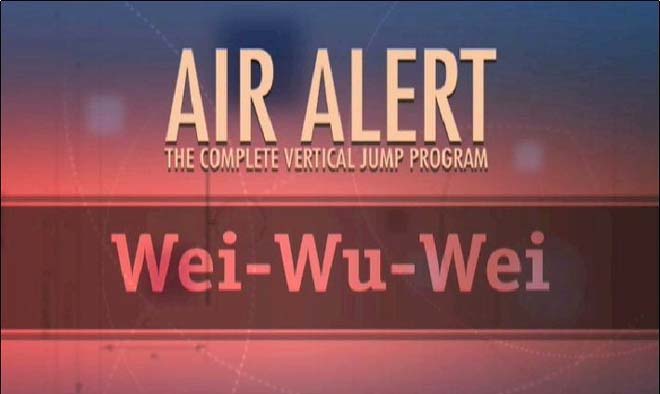
Contents
“Does Air Alert work?”
“Can it really add 10 inches to my vertical?”
“Is it safe?”
I get these questions every day from young aspiring athletes looking to improve their vertical.
Each time I’m relieved that I can warn these people about how dangerous Air Alert really is.
Unfortunately, I had to find that out the hard way.
More than a dozen years ago, I tried Air Alert myself, and it almost ended my career at age 13!
So, if you don’t want to make the same mistake I made and risk causing permanent damage to your knees, you simply must read this review.
In it, I’ll tell you why Air Alert is the worst vertical jump training program that was ever created and why you should avoid it at all cost.
Then, I’ll give you a few programs you can do instead which actually work!
Ready?
Let’s get down to business.
Why Air Alert
There’s simply no way of ignoring Air Alert – it has been around the longest, was used by thousands of people, and has a lot of contradicting information on it online.
Seeing so many people asking questions about the program online always makes me anxious – I know firsthand how bad using Air Alert can be.
That’s why I decided to write this review.
Hopefully, it can steer at least some folks away from this dangerous program that not only doesn’t work but can be straight up dangerous.
My Personal Experience
I’ve had personal experience with the program even before I knew anything about vertical jump training.
When I was just entering my teenage years and still dreaming of one day rocking the rims of NBA arenas, I heard stories from my teammates about this mysterious program that could help you become a sick dunker.
Obviously, that was not the case.
I’m not sure where these stories came from, but my guess is that since there wasn’t any alternative for jump training at the time, when people saw naturally gifted leapers, they associated it with some ‘secret formula’ instead of genetics or plain hard work.
Anyway, since I was young and easy to convince, I decided to try Air Alert for myself.
I was quite determined to jump higher, and thus I pushed through the exhausting workouts for weeks, hoping that at some point it’ll finally ‘click’ and I’ll become the ferocious dunker I always wanted to be.
But instead, I ended up with patellar tendonitis at age 13, and needed to skip large parts of the season due to knee pain.
Luckily, my knees were able to recover because I was still so young. But since then, I’ve been warning anyone who’d listen about the dangers of using Air Alert.
All these years later, I still count myself lucky for not causing more severe damage to my knees. However, I would have been happier to stumble upon a review like this back then.
Author of Air Alert
There isn’t too much to say about Timur Tukel.
He released the program back in 1991, after developing the Habitual Jump Training approach that the entire program is based on.
Since then, he has continued to market the program to this day, releasing three more editions after the original launch.
Recently, Tukel has been promoting his Court Controller Dribbling Masks in combination with Air Alert.
And that’s just about it. There’s really not much more I could find out about the guy.
He’s marketing his products, but I have no clue what his credentials are or if he even has anything to do with basketball.
But enough about the author, let’s analyze the actual program itself.
What Is Air Alert?
Air Alert is a vertical jump training program that promises to increase your jumping ability by at least 8 inches in just under four months of training.
But, as you might have already guessed, these promises have little chance of becoming a reality. At least not if you actually follow the program as the author wants you to.
Since its release in 1991, Air Alert has been used by thousands of athletes across the world. Some of them might have seen marginal results, but for many others, the program was ineffective or even flat out dangerous.
Many have had their dreams of dunking shattered by knee problems.
But why is Air Alert so ineffective?
Let’s find out.
Air Alert Core Principles (And Why They’re Flawed)
Air Alert is a plyometrics-only program that’s built around the ideas of habitual jump training.
What is habitual jump training, you might ask?
It’s a vertical jump training theory that says that increasing exercise repetitions will gradually lead to improvement in vertical jump ability.
Each week, the number of reps is increased until you are jumping thousands of times every single workout.
Sounds crazy, right?
Well, you’d be surprised how much people are willing to push their bodies when they believe it will transform their jumping ability.
Unfortunately, it simply doesn’t work that way, and the reason for that, lies in the way our muscles are engineered to make improvements.
You see, the ability of our muscles to perform depends entirely on the kind of activity they are subjected to. That’s why people who lift heavy become stronger, people who run long distances develop better endurance, and people who engage in gymnastics are often very flexible.
This is called the principle of specificity, and it’s one of the most foundational elements in sports science.
So when you’re doing thousands of jumping movements every workout, your muscles adapt to that activity as well. They adjust to the fact that they have to do an incredible number of reps and they start to conserve energy in order to be able to perform them.
This means that instead of training for explosiveness (jumping higher), you end up training for endurance (being able to perform jumping movements for long periods of time).
To put this into context, imagine that you have to train for a 100-yard dash.
If you train by running two miles each day, all it will do is make you better at running the two-mile run (endurance).
If you want to improve your sprint speed, you would need to train like a sprinter by running short distances and training your muscles to run at their max capacity for short periods of time (explosiveness).
If you want a real-life example, why not listen to the best sprinter ever?
Usain Bolt, who’s an eight-time Olympic gold medalist and the best sprinter of all time, has NEVER run a mile in his life.
Not because he was lazy, but because he knew that it would actually hurt his performance.
Instead, Usain trained his muscles for the specific movements required to run as fast as possible and nothing else.
To be able to dunk a basketball, the process is very similar.
The Real Science for Explosiveness
If you want the bare-bones formula that is behind every effective vertical jump training program, it’s this:
Explosiveness = Strength x Quickness
Countless factors contribute to a person’s vertical jump, but the strength of your muscles and how quickly you are able to use it is all that’s behind athletic freaks like Vince Carter, Nate Robinson or Zach LaVine.
So how do you train for explosiveness?
When you think about it this way, it becomes obvious that training by doing thousands of jumps is definitely not the answer.
Instead, what really matters is that your muscles are challenged with every jump and that all movements are done with maximum effort.
Exercises like squats and deadlifts are essential for building a strong base, but even they are not absolutely necessary.
And as evidence, plyometric-only programs such as Vert Shock, the hottest program on the market right now, have been able to produce results to thousands of athletes without ever lifting a single weight.
But no matter what program you consider, one thing’s for sure – if it asks you to do more than 10-15 reps of an exercise, it probably isn’t following the right principles.
As for Air Alert and its hundreds of repetitions of each exercise, it’s about as far from correct training as you can get.
Air Alert’s Workouts
Air Alert is by no means unique.
The six exercises used in the workouts are variations of very basic plyometric movements. These have been available for decades and aren’t inherently bad, but they definitely won’t bring results when used in the way that Air Alert wants you to.
In fact, some of them actually have a place in an effective vertical jump training routine, but only at the right place and with a more reasonable amount of reps.
Again: not the way Air Alert wants you to do them.
You’ll have to do all six exercises during every workout, and you’ll be training three times per week.
While that doesn’t seem too bad, you have to remember that towards the end of the program, you’ll often do up to 1,500 jumps per workout (!), which means you will likely have trouble walking afterward.
Even for endurance training, these kinds of workouts are CRAZY and dangerous. And for explosiveness, they’re the last thing you should be doing.
Why Air Alert Is so Dangerous
It’s easy enough to see why Air Alert doesn’t help you become an explosive dunker, but why is it dangerous?
The short answer is that the number of repetitions is simply too high.
Even professional athletes are very careful about the workloads that they put their bodies through. For teenagers and young adults, that holds even truer.
When your body gets exposed to such a crazy volume of jumps, it’s unable to handle the pressure that’s put on the ligaments and the knees.
What’s more, when your knees have to withstand thousands of hits every time you come down from a jump, they can get damaged only after a few workouts.
This is another area where newer vertical leap training programs are so much better.
For example:
When following a program like The Jump Manual, you will almost never be asked to do more than 5-8 reps of an exercise.
That way, you not only protect your knees, but you can also train with maximum intensity, which is how you improve your vertical in the first place.
Pros & Cons
It’s hard to find any real pros to a program that’s as flawed as Air Alert, but since this is a review, I’ll try to remain objective.
So here we go.
Pros
Cheap. If there’s one thing Air Alert has going for it, it’s the price. You can get it for as little as 10 bucks, which is far less than any of the competitors. That said, even if you could find it for free, Air Alert still wouldn’t be worth your while – the program’s methods simply don’t work, so I wouldn’t waste my time with it even if I was paid to use it.
Good Cardio Workout. If you’d look at Air Alert not as a vertical jump training program, but as a cardio workout, it would actually make more sense. It would still be a poor choice, as the exercises are boring and the number of jumping movements doesn’t make sense. But you’d at least be able to see some improvement in your endurance. That being said, the training methods still don’t have anything to do with science-based vertical jump training.
Can Provide Limited Results. I’m not going to tell you that Air Alert is good and can work for you. But the truth is, if you’re a complete beginner and haven’t done any jump training in your life, you might see small improvements. That’s because, at that point, your muscles would respond to any kind of activity. However, those that might actually see some results with the program are also at the most risk of developing chronic knee injuries – their muscles and ligaments simply aren’t used to being pushed to such extreme strain.
Cons
Flawed Science. Any objective review of Air Alert has to start and end with the fact that its approach simply doesn’t work. The science behind the program was flawed and ineffective back then, and it’s flawed and ineffective now. Habitual jump training isn’t based on any real vertical leap science and is nothing more than a marketing term created to make sales.
Dangerous. Timur Tukel’s program deserves plenty of criticism simply because it doesn’t work, but that’s not even the worst part. It’s one thing to train hard for months and barely see any results, but it’s another to suffer a career-ending injury because of the program’s flawed principles. Air Alert has caused thousands of athletes to develop conditions like jumper’s knee and shin splints, with many others suffering even more serious injuries.
Extremely Difficult. Air Alert’s crazy number of repetitions makes it one of the most difficult training programs out there. Established programs like The Jump Manual or Vert Shock require much less effort while delivering much better results.
Not for In-Season Training. Even if you wanted to do the program, you’d face a real challenge if you hoped to combine it with playing basketball. With the insane amounts of reps (which sometimes go into the thousands), you’d be lucky if you’re still standing after the workouts. Playing basketball would be the last thing on your mind.
Poor Presentation. The program is nothing more than a simple black & white PDF and some videos, so in terms of presentation, it’s literally decades behind what the current leading programs have to offer.
Can’t Compete with New Programs. Back in the early 90s, Air Alert was the only real option for people who wanted to dunk – there was simply no alternative for it. But today, when we have other effective and proven programs available, you don’t even have to consider Air Alert as an option.
Programs to Try Instead
Since it’s obvious that Air Alert is the worst possible option for vertical jump training, I think it’s important to provide you with some alternatives.
Here are a few programs that have stood the test of time and have become the staples of the vertical leap training community.
They all have their strengths and weaknesses and aren’t perfect for everyone, but if you follow any of them correctly and ’till the end, you’re basically guaranteed to achieve significant gains to your leaping ability.
The Jump Manual

Released over a decade ago, The Jump Manual instantly became a revelation to anyone that wanted to become a dunker.
Instead of having to rely on word-of-mouth, people finally had a science-based proven program that could turn anyone from an average athlete to a dunking machine.
Developed by a world-famous trainer and dunker Jacob Hiller, The Jump Manual goes deep into every little part of vertical jump training, covering even secondary aspects such as form, nutrition, flexibility and more.
It’s a program that doesn’t hold back and gives you all the tools necessary to reach your jumping potential.
Still, don’t think it’s a magic solution.
The Jump Manual employs advanced strength and plyometrics exercises that rarely require you to do more than 5-8 reps of an exercise, but it’s still hard work.
You will need to dedicate yourself every single day, even when there are no workouts scheduled. Diet, stretching and even sleeping are just as important to your success as the workouts themselves.
Add in the fact that one of the two weekly workouts takes place at a gym, and you’ve got yourself a program that requires quite a lot of time.
So while there’s no doubt that it’s very effective, the time commitment required means that it’s definitely not for everyone.
Luckily, if you don’t have time or access to a gym, there’s a program that can be just as effective without it…
Vert Shock

The Jump Manual was the first program that gave ordinary athletes a clear guide on how to become an explosive dunker.
The problem was, it required a lot of time and resources. More than what many high-schoolers or young adults had.
That’s where the Vert Shock program came in.
Released just a few years ago, it quickly became the hottest product on the market – people of all ages could now realize their dream of dunking without complicated training routines or advanced training equipment.
The program was relatively quick, easy to understand, and incredibly effective.
Adam Folker and Justin Darlington, the creators of the program and reputable trainers themselves, have managed to distill the complicated science of vertical jump training into a handful of exercises, all of which don’t require any equipment and can be done outdoors or even in your garage.
Thousands of people (including myself) have experienced the effectiveness of the program firsthand, so if you want a comprehensive dunking program that can work around your busy schedule, you can’t go wrong with Vert Shock.
BoingVERT

I also have to mention BoingVert, a program that has an almost cult-like following on social media and YouTube.
The program has been developed by renowned trainer Shawn Myszka and has plenty of testimonials online claiming it brings amazing results.
I have analyzed BoingVert myself a while back and have found that it’s not up to par with The Jump Manual/Vert Shock as it simply not as refined.
However, it still has plenty of solid info and could be effective. One thing’s for sure – it’s still a thousand times better than Air Alert.
Bounce Kit

Bounce Kit is a growingly popular training program that’s built around the personal brand of Jordan Kilganon – a dunking celebrity who’s taken the world by storm with his signature one-of-a-kind slams.
But once you look past his incredible leaping ability and analyze the program’s principles, it’s easy to see that Bounce Kit is no match for leading programs such as the ones mentioned above.
Bounce Kit is unfinished, lacks direction, and doesn’t tackle some of the essential aspects of vertical jump training. You could get some results with it, but they won’t be nearly as good as with The Jump Manual or Vert Shock.
However, I must repeat that it’s still infinitely better than Air Alert, and it’s got an excellent weight training regimen, so it deserves a mention on this list for that reason alone.
Summary
Air Alert is difficult to judge by the same standards as the other vertical jump training programs on the market.
While some of them are poorly prepared, lack structure or simply aren’t very effective, they are still miles ahead of Air Alert because at least they’re not as dangerous.
I can’t emphasize enough how much I urge you not to give Air Alert a shot even if you found it for free online. You’re much better off simply doing nothing because at least that way your knees will stay healthy.
Luckily, if you really want to become a ferocious dunker, there are great options available.
So instead of taking a huge risk with Air Alert, invest into proven programs like the ones mentioned which are safe, tested, and will bring you results.
Last Updated on by Matthew Godley






I used AA II back in the early 2000s as a 15 year old. I had average athleticism and was on the thin side.
I did 6 of the 12 weeks because it simply became too burdensome as the reps became so high.
It hardly did anything to help my jump. I probably went from 15″ to 19″ vertical which is not that much.
However, it did help my endurance. I would jog for 3 or 4 hours without stopping.
Would I recommend Air Alert today? Only if you’re a marathon runner.